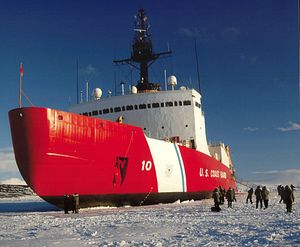This Wednesday, the U.S. Coast Guard made a first step in its quest to accelerate the construction of additional polar icebreakers, by announcing a Federal Business Opportunities solicitation for the so-called Polar Class Icebreaker Replacement Program. The move came amid criticism that the United States is falling behind Russia and even China in the number of ice breaking vessels it can field.
According to the announcement, the Coast Guard intends to host an Industry Day followed by one-on-one meetings with prospective shipbuilders and ship designers as a part of ongoing market research in March 2016 in Washington, D.C.
A draft technical data package document outlines a tentative polar icebreaker acquisition schedule, although it specifies that “the Polar Icebreaker Program has not yet chosen an acquisition strategy” and that “[t]he request for proposals is the only document that should be relied upon in determining the Coast Guard’s official requirements.”
The notional schedule for the acquisition of a new polar icebreaker foresees the release of an official request for proposals by the end of 2017, a contract award sometime between the last quarter of 2018 and the first three quarters of 2019, and a construction phase from the last quarter of 2019 to the end of 2020.
According to the document, mission sets for the new icebreaker will include ice operations, defense readiness, search and rescue, marine environmental protection, and law enforcement among others.
One of the biggest advocates for the acquisition of at least two new icebreakers is the head of the U.S. Coast Guard, Admiral Paul Zukunft, who sees icebreakers as a pivotal element in the Coast Guard’s arctic strategy. “I have also signed up an operation requirement document that has been pushed across from DoD [Department of Defense], Department of Interior, Department of Commerce, National Science Foundation [and the] Arctic Research Council. We have a lot of people interested in the Arctic,” Zukunft said at the annual Surface Navy Association Symposium held this week outside Washington, D.C.
“We have President Obama, in Alaska, saying we need to accelerate the build-out of icebreakers,” he added, according to Defense News. “I’m pretty sure I heard an ‘s’ at the end of that.”
In September 2015, the White House published a fact sheet in which it pledged to help facilitate the acquisition of new icebreakers: “[T]he Administration will propose to accelerate acquisition of a replacement heavy icebreaker to 2020 from 2022, begin planning for construction of additional icebreakers, and call on Congress to work with the Administration to provide sufficient resources to fund these critical investments.”
As I reported previously, (See: “Russia and China in the Arctic: Is the US Facing an Icebreaker Gap?”), the United States currently operates two polar icebreakers: the Polar Star and the Healy. However, only the Polar Star is a heavy icebreaker capable of accessing all of the Arctic year-round. (The Polar Star’s sister ship, the Polar Sea, had a major engine breakdown in 2010 and has not been operational ever since.) Furthermore, the Polar Star, commissioned in 1976, is slated to reach the end of its operational lifespan in 2020.
Procuring new polar icebreakers will not be an easy endeavor. As I pointed out:
First, it would need to find a way to circumvent the standard acquisition approach that would take the Coast Guard about ten years to build a new ship. (…) Second, the U.S. Coast Guard is facing severe budgetary constraints. The money ($1 billion) it would need to kick-start the development and construction of a new icebreaker is equivalent to the entire acquisitions budget of the Coast Guard for 2015, and it is highly unlikely that the service branch will receive additional funds in fiscal year 2016.
However, Zukunft does not appear willing to take no for an answer. “We often come to this discussion of, well, we really can’t afford it. Our [gross domestic product] is over eight times that of Russia — yet Russia’s building 14,” he said, according to Defense News. “I do not advocate that we go after the Navy’s shipbuilding budget. But right now, these icebreakers are strategic assets as well.”
Zukunft is working hard to convince U.S. Congress to appropriate funds for the Coast Guard’s 2017 budget, National Defense Magazine reports. “I have been in very active dialogue” with Capitol Hill, he said. “I would not be investing in [this] acquisition step — I would not take the time to push out an operation requirement document, the work that that takes — if I didn’t have any faith that in the future we will see an appropriation to address icebreakers. (…) I can’t talk about what’s going to be in the ’17 budget, but trust me, I’m working on it.”
Russia currently operates 40 icebreakers and has another 14 (some sources say 11) planned or under construction. Out of the 40, around 27 are ocean-going icebreakers, some of which are nuclear-powered. China is expected to commission its second icebreaker by 2016.

































